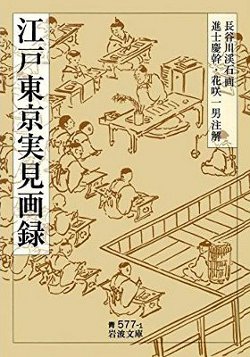An Edo kid born in Nihonbashi Namba-cho (later Naniwa-cho), was published by Iwanami Bunko (Blue 577-1) by Iwanami Bunko (Blue 577-1) with commentary based on paintings and sentences depicting events and customs from late Tokugawa shogunate to the early Meiji era.
 It was drawn by Keiishi Hasegawa, the first female Kabuki writer and the father of Shigure Hasegawa (1879-1941), who wrote "Old Mon Nihonbashi".
It was drawn by Keiishi Hasegawa, the first female Kabuki writer and the father of Shigure Hasegawa (1879-1941), who wrote "Old Mon Nihonbashi".
The mountain stone is made of real name. Born in 1842 (1842), he studied painting at Kuniyoshi Utagawa, a Genji store, while at the beginning of Shusaku Chiba Dojo. After entering the Department of Prison in 1869 (1869), he became a protagonist (later lawyer). He died in 1918 at the age of 77.
There are 52 figures in this book. In addition to Edo Castle (Miyagi) relations such as "Shinson's Imperial Castle" and "Nishi-Marudai-mae", there are many themes around the current Chuo-ku, so I am interested. While scenes in the lives of ordinary people such as "Search for lost children", "Yomiuri in the city", and "Children's play" are depicted, there are also figures related to punishment, such as "All maps of the former Shogunate prison" (Kodemmacho prison), "Kakeboshi" and "Handchain Ink".
The valley stone drew a picture and a story, but since this book has an expert's attention, you can understand the background of the times. From Edo to Tokyo, the state of the Chuo-ku area during the era of transformation emerges. @ Akira Makibuchi

